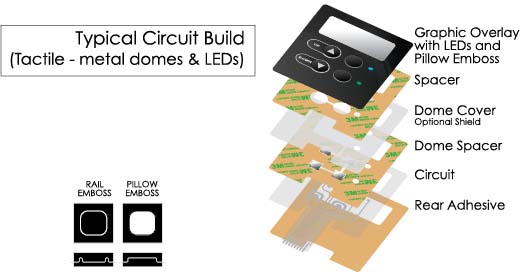How Membrane Switch Technology is Revolutionizing User Interfaces
How Membrane Switch Technology is Revolutionizing User Interfaces
Blog Article
Understanding Membrane Layer Switches: The Secret to Sturdy and Trustworthy Controls
What Are Membrane Buttons?
Membrane switches are an advanced option in the world of interface technology, integrating performance and layout seamlessly. These devices act as an interface between individuals and digital systems, incorporating numerous parts right into a portable layout. Typically constructed from flexible, thin layers of materials, membrane switches are designed to reply to touch, enabling customers to interact with equipment and digital tools properly.
The key components of a membrane layer button include a printed circuit layer, graphic overlay, and a spacer layer that prevents unintended activation. The visuals overlay can be tailored to mirror brand name identity or user choices, boosting aesthetics while ensuring use. Membrane layer switches are typically utilized in numerous applications, consisting of medical devices, customer electronic devices, and industrial equipment, owing to their durability and resistance to ecological aspects such as moisture and dirt.
Among the essential advantages of membrane layer switches is their ability to endure wear and tear, making them ideal for high-traffic settings. Furthermore, they are lightweight and call for marginal area, permitting ingenious designs in item growth. Generally, membrane layer switches stand for a effective and useful selection for contemporary digital interfaces, weding innovation with user-centric design concepts.
How Membrane Switches Job
The operation of membrane layer switches hinges on a simple yet efficient mechanism that equates customer input into digital signals. These buttons contain numerous layers, usually consisting of a graphic overlay, a spacer layer, and a circuit layer. When a customer presses the switch, the top layer flaws, allowing a conductive aspect in the circuit layer to reach a corresponding conductive pad on the bottom of the visuals overlay. This get in touch with shuts the circuit and sends out an electronic signal to the gadget, showing that the switch has been triggered.
The layout of membrane switches can vary, however they usually incorporate domes or tactile aspects to supply responses to the user, enhancing the overall experience - membrane switch. The materials utilized in membrane layer buttons, such as polyester or polycarbonate, add to their durability and resistance to environmental elements, including wetness and dirt. The printed circuits are normally enveloped, which protects them from wear and tear over time.
Advantages of Membrane Buttons

Additionally, membrane switches are understood for their longevity. Constructed from robust products, they are resistant to dust, dampness, and physical wear, which substantially prolongs their life expectancy contrasted to traditional mechanical switches. This longevity makes them specifically suitable for high-traffic environments and applications needing longevity.
Another substantial benefit is the ease of cleansing and upkeep. The smooth surface area of membrane changes lessens dirt accumulation and is typically resistant to spills, making them excellent for settings that need frequent sanitization.
Additionally, membrane layer buttons offer a streamlined profile, resulting in a thinner layout that can be incorporated into various devices without adding mass. This function not only enhances the visual charm this post however likewise adds to a more ergonomic item style.
Applications of Membrane Buttons
Straightforward and flexible, membrane buttons discover applications across a large range of markets, including clinical devices, customer electronics, and commercial tools. In the medical area, these buttons are essential to tools such as diagnostic equipment, individual tracking systems, and infusion pumps, where integrity and simplicity of cleansing are essential. Their capability to withstand extreme environments and keep performance makes them ideal for such applications.

In consumer electronics, membrane switches are used in items like microwaves, washing devices, and push-button controls - membrane switch. Their sleek style permits intuitive interface, boosting the total user experience while providing resilience and resistance to wear and tear
Industrial tools also gains from membrane layer buttons, particularly in control panels for machinery and automation systems. These buttons provide protection versus dirt and wetness, ensuring regular efficiency in tough environments. Their adjustable features enable manufacturers to customize them to certain functional needs, improving efficiency and capability.
Picking the Right Membrane Layer Switch
When choosing a membrane button, it is necessary to think about different variables that affect efficiency and suitability for certain applications. The primary factors to consider include environmental problems, tactile responses, toughness, and style specifications.
First, evaluate the operating environment; switches revealed to wetness, chemicals, or severe temperature levels require particular materials to ensure durability and performance. Next, assess the need for tactile responses. Depending upon individual interaction, some applications might gain from a tactile feedback to verify activation, while others might choose a non-tactile layout for aesthetic reasons.
Toughness is another essential aspect; membrane switches should be designed to withstand regular use, effects, and abrasion. Guarantee the picked switch can endure the anticipated lifecycle, specifically in high-usage circumstances.

Conclusion
To conclude, membrane layer switches over act as important components in the layout of sturdy and reliable control systems across numerous sectors. Their compact layout, integrated with robust building and personalized functions, boosts individual communication while guaranteeing durability popular atmospheres. The versatility of membrane layer switches over permits tailored options that satisfy particular operational needs, reinforcing their importance in modern-day innovation. As industries proceed to advance, the importance of integrating reliable membrane layer button remedies can not be overemphasized.
Membrane switches over represent an essential element of modern user interface layout, mixing functionality with resilience Homepage in different applications.Membrane switches are a sophisticated solution in the world of individual interface modern technology, integrating capability and design seamlessly. Normally constructed from adaptable, slim layers of materials, membrane layer switches are developed to react to touch, enabling individuals to connect with machinery and electronic gadgets properly.
The layout of membrane layer buttons can differ, however they commonly include domes or responsive elements to offer comments to the user, enhancing the overall experience.In verdict, membrane layer switches over serve as essential parts in the layout of trusted and sturdy control systems throughout different industries.
Report this page